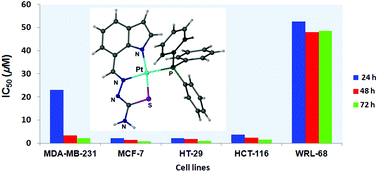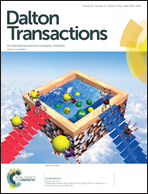Indole-7-carbaldehyde thiosemicarbazone as a flexidentate ligand toward ZnII, CdII, PdII and PtII ions: cytotoxic and apoptosis-inducing properties of the PtII complex†
Abstract
A new thiosemicarbazone (LH2) derived from indole-7-carbaldehyde was synthesized and reacted with ZnII, CdII, PdII and PtII salts. The reactions with zinc and cadmium salts in 2 : 1 (ligand–metal) molar ratio afforded complexes of the type MX2(LH2)2, (X = Cl, Br or OAc), in which the thiosemicarbazone acts as a neutral S-monodentate ligand. In the presence of potassium hydroxide, the reaction of LH2 with ZnBr2 resulted in deprotonation of the thiosemicarbazone at the hydrazine and indole nitrogens to form Zn(L)(CH3OH). The reaction of LH2 with K2PdCl4 in the presence of triethylamine, afforded Pd(L)(LH2) which contains two thiosemicarbazone ligands: one being dianionic N,N,S-tridentate while the other one is neutral S-monodentate. When PdCl2(PPh3)2 was used as the PdII ion source, Pd(L)(PPh3) was obtained. In a similar manner, the analogous platinum complex, Pt(L)(PPh3), was synthesized. The thiosemicarbazone in the latter two complexes behaves in a dianionic N,N,S-tridentate fashion. The platinum complex was found to have significant cytotoxicity toward four cancer cells lines, namely MDA-MB-231, MCF-7, HT-29, and HCT-116 but not toward the normal liver WRL-68 cell line. The apoptosis-inducing properties of the Pt complex was explored through fluorescence microscopy visualization, DNA fragmentation analysis and propidium iodide flow cytometry.


 Please wait while we load your content...
Please wait while we load your content...